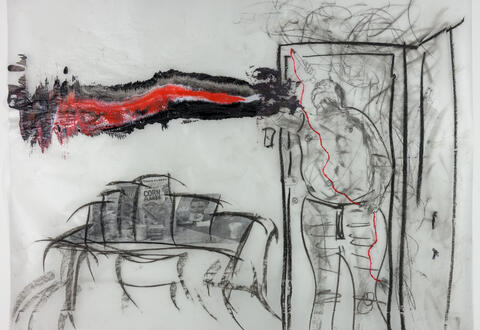![[ Fig. 01 ] Fountain (video still), 2005.](/sites/default/files/styles/fixed_width_480/public/advancedpublications/scenarios/13139/x055q43b-24-30exception.jpg,qitok=zNeBhiKT.pagespeed.ic.zML4i6O9sY.jpg)
Scripts
These scripts were written by Donigan Cumming in 2006 as stand-alone works that draw on videos made since 1996. As with his drawings, photo-montages and collages, Cumming has reused elements of previous works to produce new ones, only this time using text. In this way he ensures that “nothing gets wasted”.
Rather than simple transcriptions, the texts follow the codes of scriptwriting, with typical page layout and indications of time and place, actions, and voice-overs. These standardized documents, though reverse engineered, constitute a strategy by the artist to inscribe the works in the cinematic field, a strategy to which he adds his exploration of different genres (film bio, romance, western). Of course, his practice is situated in the most extreme margins of cinema. Nevertheless, it is precisely because he insinuates himself into these different processes that he can manipulate them.
In his first film, A Prayer for Nettie, Donigan Cumming had placed Albert at the heart of the posthumous tribute to Nettie, his former model. One year later, he composed Cut the Parrot, a new requiem intended for Albert, who also died amid total indifference. As in his previous film, the filmmaker gathered a series of eulogies in honour of the deceased from the people, some close and others not so close, who were emotionally affected by his death. But this film differs from the previous one in that it seems to be based not only on respect but also on an intense anger. Several times Donigan films his own face and angrily tells about how he was informed of Albert's death or about his visit to the morgue to identify the body. From then on the principle behind his cinematographic quest seems clearly exposed: no life, however marginal it may seem, should end in such a way, without any consideration. Through their testimonials that contribute to giving a meaning to Albert's life, to saving him from the common grave, these fragile characters who express their fondness reveal their own grace, like the epileptic woman who sings Que sera with such intensity.
Yann-Olivier Wicht, Visions du réel, 2002.
Translation from French: Paul Belle.
An alcoholic and potbellied fifty-year old, Pierre Lamarche has lost everything: accused of rape by Brenda, the woman he loves, he finds himself in the street after a spell in prison. Obsessed by his ex-lover, he suspects her of sleeping with the neighbours and taking up prostitution.
Confiding his misfortunes to the camera in the same way as he would submit himself to therapy, Pierre considers himself rather like the producer of a film on his life. A real ham actor, he gets into his stride and lavishes his tale with exaggerations and spicy details. For his part, Cumming directs his makeshift actors, sets the scene and provokes encounters as the master of ceremonies of what he himself describes as a lowbrow novel. Using a complex narrative technique, he juxtaposes on Pierre's tale his own remarks as well as a second, more morbid story, quite distinct from the first and told by a character who a priori has no connection with the principal drama. Here the documentary flirts clearly with fiction: each character plays his own role, including the filmmaker: shrewdly, he collects the scattered fragments of this affair rather in the same way as a detective, enters apartments and leaves after recording on the video tape miscellaneous exhibits - Brenda's knickers... - and pieces of indecent evidence. In its sordid yet humorous dimension, After Brenda reveals an elliptical and explicitly manipulated reality. Disconcerting at first sight, this film is nevertheless a mirror image of Pierre's life: an ordinary mixture of established and fantasized facts.
Sophie Guyot, Visions du réel, 2002.
Translation from French: Angela Bennet.
Are erratic angels fallen angels? When we meet forty-eight-year-old Colin, the main character of the film, he is walking under the flyover of a motorway. He is on foot while those who play the game by society's rules whizz by a few feet above his head at the driving wheels of their Cadillacs. He dropped out long ago and lives alone forgotten by his family. He used to be a junkie and an alcoholic, now he is a marginal and develops analytical and self-justifying arguments which sometimes turn into a flow of jumbled words. Cumming introduces us to the everyday realities of this character with honesty. Filming on his own in video, he takes a different approach from the usual portrait, he doesn't magnify anything, nor does he idealise, he simply shows the raw truth: nakedness, destitution, lies, but also regrets, tenderness or the expression of common sense. Sequences follow showing each detail of Colin's life in the manner of a rigorous Perrec who from the description of a pile of objects or from a haircut sketches the main events in a life. This research is rendered sensitive through a formal approach using a steady cam and which allows Cumming to let his eye wander. Without distracting from speech the hand directs the lens beyond the face to enrich the word with shots that step out of sequence, out of the frame, and to where reality is shown as it is. This reality sometimes makes one feel uneasy but this uneasiness is the strength of erratic angel.
Yann-Olivier Wicht, Visions du réel, 1999.
After having been for a long time a photographer of the human body, Donigan Cumming has for the past five years turned to the cinema. His films are uncompromising portraits of people whose lives are painful ordeals, If Only I features Colin, the ange of Cumming's previous film, Erratic Angel. Colin has taken into his home Colleen, a woman who “fell from the nest” on a day when suicide seemed the only way out. She is now confined to a wheelchair. Cumming narrates the start of her new life. The film's title is taken from the opening sequence, in which Colleen goes over her past: if only I had not left my husband, if only I had not become attached to that other man... In this way she proceeds to rewrite her whole story or, as she says, her tragedies. How does Cumming achieve such a feeling of trust that a single question of his is sufficient to bring Colleen to tell, apparently calmly, about so many violent experiences such as addiction, incest and suicide? The keystone of his filming technique is the close-up, which becomes almost unbearable when a scar or a ravaged face persistently occupies the screen. For Cumming hides nothing of the day-to-day life of this unusual couple. He allows his characters' anger and bitterness to be expressed in long shots.
The appeal of this film lies not in the enjoyment of what we see but in the emotion created by the raw reality that unfolds before our eyes and the rigour with which the film-maker handles his subject. The transposition of reality into image forgoes any decorative style and becomes - literally - a language of direct communication. Cumming's cinema remains as close as possible to speech in order to avoid diluting words and eroding their meaning. His films impact us forcefully, disturb us, and his cinema - sometimes described as the "video of cruelty" in reference to the concept of the body in Artaud 's theatre -seems to take the documentary to its utmost limits. This cinema, provocative for the spectator but definitely part of a consistent creative approach, presents harsh reality just as it is. The film will leave its mark and stay with you for a long time.
Yann-Olivier Wicht, Visions du réel, 2002.
Stammering in front of the lens, a man tells of a mishap. The camera records his story, framing his face from very close to, then moving slightly away, then returning to the original close-up of the opening shot. The story then seems to carry on normally. However, without any apparent cut, the scene is shown to us played backwards, then the right way round once again. The loop is repeated in this way three consecutive times, finally giving rise to a false sequence shot lasting three minutes. At the same time, the sound rapidly dissociates itself from the picture. Although at first the monologue carries on normally when the scene is shown backwards, it is subsequently also played backwards or superimposed on the direct sound. This obsessional loop finally ends with the picture suddenly freezing on the character as he closes his eyes, while the sound, completely distorted, has become inaudible. Wrap is a film that stutters. Donigan Cumming amuses himself adapting the language of cinema to his subject in an extreme way. The multiple repetitions give an unexpected dimension to the recorded document. Taking advantage of the usual codes of documentary realism, the filmmaker envelops this fragment of reality with a new perspective.
Christian Bovey, Visions du réel, 2002.
Translation from French: Angela Bennet.
In My Dinner With Weegee is not about the photojournalist Weegee but about Marty, who used to socialize occasionally with him in New York in the 1950s. Now in his seventies, Marty shares with Donigan Cumming his memories of these and other encounters with artists, writers and activists. These lively stories of the past contrast sharply with Marty's desolate old age, which is dominated by bad health, alcoholism, loneliness, and money troubles. In the film Cumming pushes Marty to reveal as many facets of himself as possible, even literally exposing himself while urinating. If, in one scene, Marty's charm shines through as he sings a few bars of a song, in another we see him groping with trembling hands for a bottle of beer.
Cumming is open about his own multi-faceted rôle in the film (and in real life?) as Marty's friend, biographer, caretaker and inquisitor. He alternately helps him take his medication, nags him about his alcoholism, and shares his own memories with the older man. In one scene he swivels the camera back and forth between his face and Marty's, turning his questions about Marty's drinking into a filmic interrogation. And at several points, Cumming recites statements about his own alcoholic past, his decision to leave the USA during the Vietnam war, and his fascination with aging, decline and loss. In spite of the stilted language and stagey delivery, these remarks amount to a confession of sorts, making My Dinner With Weegee one of Cumming's most personally revealing films.
Marcy Goldberg, Visions du réel, 2002.







![[ Fig. 01 ] <i>Voice: off</i> (video still), 2003.](/sites/default/files/styles/publication_teaser/public/advancedpublications/videos/13184/x04voiceoff0.jpg,qitok=mOKWhuRE.pagespeed.ic.cl977wU3n4.jpg)
